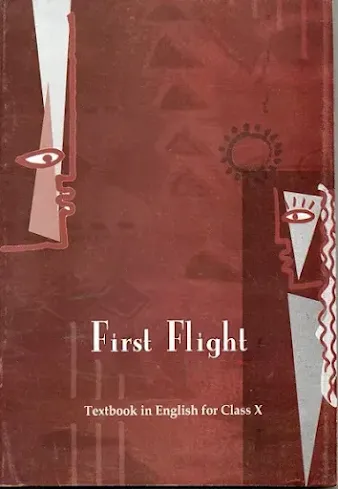Summary of the poem:
The poem describes a majestic tiger walking inside a small cage. Its beauty is highlighted through its striking stripes and soft, velvety paws. However, the tiger is not happy; instead, it is angry about its confinement. The poet imagines that if the tiger were free, it would be hiding in tall grass near a water body, waiting to hunt a deer. It would also instill fear in the villagers living near the forest. But in reality, the tiger is trapped in a cage made of strong materials, leaving it helpless. It cannot showcase its strength to the visitors and, therefore, does not try to scare them. The poet portrays the tiger as powerless and suffering. At night, the tiger remains alone, listening to the sounds of patrolling police vehicles while gazing at the stars. The captivity has completely changed the tiger’s personality. The poet emphasizes how this once fearless and powerful animal has been reduced to a sad, confined creature, while people merely enjoy watching it in the zoo.
কবিতাটোত এজন মহানায়কীয় বাঘৰ বৰ্ণনা কৰা হৈছে, যি এখন সৰু খাঁচাত হেলিদেই ফুৰি থাকে। তাৰ সৌন্দৰ্য উজ্জ্বল ডোরা আৰু মখমলৰ দৰে কোমল ঠেঙেৰে প্ৰকাশ পাইছে। কিন্তু বাঘজন সুখী নহয়; বরঞ্চ, খাঁচাত বন্দী হৈ থকা বাবে অতি ক্ষুব্ধ। কবিয়ে কল্পনা কৰিছে যে যদি বাঘজন স্বাধীন হৈ থাকিলহেঁতেন, তেন্তে তেওঁ দীঘল গছৰ পাতৰ আৱৰণত লুকাই থাকি কোনো পানী উৎসৰ কাষত মৃগ শিকাৰৰ বাবে অপেক্ষা কৰিব। সেইটো নহ’লে, তেওঁ অৰণ্যৰ কাষৰ গাঁৱবোৰত ভয় সৃষ্টি কৰিব। কিন্তু বাস্তৱতা একেবাৰে বিপৰীত। তেওঁ এটা দৃঢ় গাঁথনিৰ খাঁচাত বন্দী, যাৰ ফলত তেওঁ সম্পূৰ্ণৰূপে অসহায়। তেওঁ নিজৰ শক্তি দর্শনকাৰীসকলৰ আগত প্ৰদৰ্শন কৰিব নোৱাৰে, এইদৰে তেওঁ কোনো ভয়ো দেখুওৱা নাই। কবিয়ে বাঘজনক অসহায় আৰু যন্ত্রণাগ্ৰস্ত ৰূপে দৰ্শাইছে। ৰাতি, বাঘজনে নিৰ্জনে থাকে, আৰক্ষীৰ টহলদাৰী বাহনৰ শব্দ শুনে আৰু তৰাবোৰলৈ চাই থাকে। বন্দী জীৱনটোৱে বাঘজনৰ ব্যক্তিত্ব সম্পূৰ্ণৰূপে পৰিবর্তন কৰিছে। কবিয়ে দেখুৱাব বিচাৰিছে যে এই একসময়ৰ নিৰ্ভীক আৰু শক্তিশালী জন্তুটোৱে এতিয়া বন্দী হৈ বিষণ্ণ জীৱন কাটাব লাগিছে, আৰু মানুহ মাত্ৰ তাৰ বন্দীত্বৰ দৃশ্য উপভোগ কৰে।
In the cage সঁজাৰ ভিতৰত | In the wild হাবিৰ মাজত |
Stalks, quiet rage, ignoring visitors, hears the sound of patrolling cars, stares at star ঘূৰি ফূৰা, খঙাল, দৰ্শনাৰ্থীৰ উপস্থিতিক আওকাণ কৰা, পুলিচৰ গাড়ীৰ শব্দ শুনা, তৰাভৰা আকাশ চোৱা | Lurking in shadow, sliding through the long grass, snarling around houses, baring his white fangs, terrorize the village বননিত লুকাই থকা, ঘৰৰ চাৰিওকাষে ঘূৰিফুৰা, গাঁও বাসীক ভয় খুওৱা |
CAGE সজা | WILD বনৰীয়া |
Few steps of his cage Locked in concrete cell His strength behind bars Terrorising the village | Shadow, long grass Snarling around houses Baring his white fangs his clows Ignoring village |
সজা | বনৰীয়া |
সঁজাৰ ভিতৰত বন্দী তাৰ শক্তিবোৰ সজাৰ ভিতৰত বন্দী | ছাঁ, ঘৰৰ চাৰিওফাঁলে ঘূৰি ফুৰা |
কবিয়ে তেওঁৰ কবিতাটো অধিক প্ৰভাৱশালী কৰাৰ বাবে শব্দবোৰ পুনৰাবৃত্তি কৰিছে। "Quiet with velvet pads" বাক্যাংশটোৱে দেখুৱাইছে যে বাঘজন খাঁচাৰ সীমিত স্থানৰ ভিতৰত হেলি ফুৰিব লগীয়া হয়। তেওঁ অৰণ্যত যিদৰে দৌৰিব পাৰিলেহেতেন, সেইদৰে এতিয়া দৌৰিব নোৱাৰে। আনহাতে, "quiet rage" শব্দযুগ্মই বাঘজনৰ ভিতৰত জমা হোৱা লুকাভূকী ক্ষোভটো প্ৰতিফলিত কৰিছে, যি খাঁচাত বন্দী হৈ থকাৰ বাবে সময়ৰ লগে লগে বৃদ্ধি পাইছে। আনকি "brilliant" শব্দটোৰ ব্যৱহাৰো কবিয়ে দুটা ভিন্ন অৰ্থত কৰিছে—প্ৰথমটো টিমটিমাই থকা উজ্জ্বল তৰাবোৰ বুজাবলৈ, আৰু দ্বিতীয়টো বাঘজনৰ চকুৰ উজ্জ্বলতা বুজাবলৈ, যি তেওঁৰ বিষণ্নতা প্ৰতিফলিত কৰে। যদি তেওঁ অৰণ্যত থাকিলেহেতেন, তেন্তে তেওঁ স্বাধীন আৰু নিৰ্ভীক জীৱন অতিবাহিত কৰিব পাৰিলেহেতেন, এই বিষয়টো কবিয়ে স্পষ্টকৈ দৰ্শাইছে।
কবিতাটোৰ ভিতৰত বাঘজনক কেনেদৰে বৰ্ণনা কৰা হৈছে?
ANS: The tiger is described as a majestic creature walking inside a small cage, with striking stripes and soft, velvety paws.
বাঘজনক এখন সৰু খাঁচাৰ ভিতৰত হেলিদেই ফুৰি থকা এজন মহানায়কীয় প্ৰাণী হিচাপে বৰ্ণনা কৰা হৈছে, যাৰ উজ্জ্বল ডোরা আৰু মখমলৰ দৰে কোমল ঠেঙ আছে।
বাঘজনৰ খাঁচাত থকা অৱস্থাৰ মনোভাৱ কেনেকুৱা?
ANS: The tiger is not happy; instead, it is angry about its confinement.
বাঘজন সুখী নহয়; বৰঞ্চ, খাঁচাত বন্দী হৈ থকা বাবে অতি ক্ষুব্ধ।
যদি বাঘজন স্বাধীন হৈ থাকিলহেঁতেন, তেন্তে কবিয়ে কল্পনা কৰে যে তেওঁৰ জীৱন কেনেকুৱা হ’ব?
ANS: The poet imagines that if the tiger were free, it would hide in tall grass near a water body, waiting to hunt a deer.
কবিয়ে কল্পনা কৰে যে যদি বাঘজন মুক্ত থাকিলহেঁতেন, তেন্তে তেওঁ দীঘল গছৰ পাতৰ আৱৰণত লুকাই থাকি কোনো পানী উৎসৰ কাষত মৃগ শিকাৰৰ বাবে অপেক্ষা কৰিব।
যদি বাঘজন অৰণ্যত থাকিলহেঁতেন, তেন্তে তেওঁ কিদৰে গাঁৱলিবোৰক প্ৰভাৱিত কৰিব?
ANS: If the tiger were in the wild, it would instill fear in the villagers living near the forest.
যদি বাঘজন অৰণ্যত থাকিলহেঁতেন, তেন্তে তেওঁ গাঁৱলিবোৰৰ মাজত ভয় সৃষ্টি কৰিব।
বাঘজনৰ বাস্তৱ অৱস্থা কি?
ANS: In reality, the tiger is trapped in a cage made of strong materials, making it helpless.
বাস্তৱতে, বাঘজন এটা দৃঢ় গাঁথনিৰ খাঁচাত বন্দী, যাৰ ফলত তেওঁ সম্পূৰ্ণৰূপে অসহায়।
8. Why does the tiger not scare the visitors?
বাঘজনে দর্শনকাৰীসকলক ভয় দেখুৱাই নকিয়াৰ কাৰণ কি?
ANS: The tiger cannot showcase its strength and, therefore, does not try to scare the visitors.
বাঘজনে নিজৰ শক্তি দেখুৱাব নোৱাৰে, এইদৰে তেওঁ কোনো ভয়ো দেখুওৱা নাই।
9. How does the poet portray the tiger in the cage?
কবিয়ে খাঁচাৰ ভিতৰত বাঘজনক কেনেকৈ বৰ্ণনা কৰিছে?ANS: The poet portrays the tiger as powerless and suffering.
কবিয়ে বাঘজনক অসহায় আৰু যন্ত্রণাগ্ৰস্ত ৰূপে দৰ্শাইছে।
বাঘজনে ৰাতি কি কৰে?
ANS: At night, the tiger remains alone, listening to the sounds of patrolling police vehicles while gazing at the stars.
ৰাতি, বাঘজনে নিৰ্জনে থাকে, আৰক্ষীৰ টহলদাৰী বাহনৰ শব্দ শুনে আৰু তৰাবোৰলৈ চাই থাকে।
বন্দী জীৱনটোৱে বাঘজনৰ ব্যক্তিত্ব কিদৰে প্ৰভাৱিত কৰিছে?
ANS: Captivity has completely changed the tiger’s personality, making it sad and confined instead of fearless and powerful.
বন্দী জীৱনটোৱে বাঘজনৰ ব্যক্তিত্ব সম্পূৰ্ণৰূপে পৰিবর্তন কৰিছে, যাৰ ফলত তেওঁ নিৰ্ভীক আৰু শক্তিশালী পৰিৱৰ্তে বিষণ্ণ আৰু বন্দী হৈ পৰিছে।
বাঘজনৰ অৱস্থাৰ বিষয়ে কবিয়ে কি বাৰ্তা প্ৰদান কৰিছে?
ANS: The poet emphasizes that the once fearless and powerful animal has become a sad, confined creature, while people merely enjoy watching it in the zoo.
কবিয়ে দেখুৱাব বিচাৰিছে যে এই একসময়ৰ নিৰ্ভীক আৰু শক্তিশালী জন্তুটোৱে এতিয়া বন্দী হৈ বিষণ্ণ জীৱন কাটাব লাগিছে, আৰু মানুহ মাত্ৰ তাৰ বন্দীত্বৰ দৃশ্য উপভোগ কৰে।



No comments:
Post a Comment